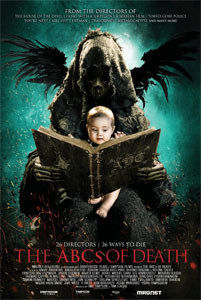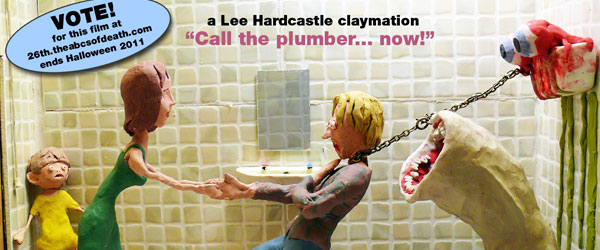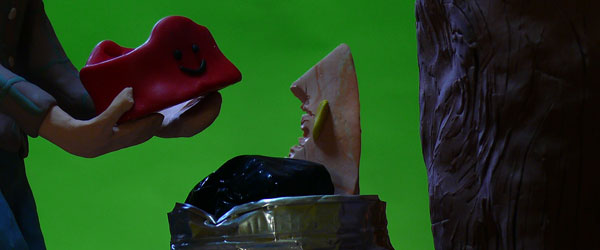 Whether you’re making a studio blockbuster, a modest independent film or even a short film, moviemaking comes with a big price tag – unless you do it Lee Hardcastle-style. Hardcastle makes movies on his own time and dime by creating claymation films and, even without high quality equipment and the assistance of skilled crewmembers, Hardcastle still manages to achieve big screen-worthy results because one of his latest shorts, “T is for Toilet,” earned him the title of 26th director of the horror anthology, “The ABC’s of Death.”
Whether you’re making a studio blockbuster, a modest independent film or even a short film, moviemaking comes with a big price tag – unless you do it Lee Hardcastle-style. Hardcastle makes movies on his own time and dime by creating claymation films and, even without high quality equipment and the assistance of skilled crewmembers, Hardcastle still manages to achieve big screen-worthy results because one of his latest shorts, “T is for Toilet,” earned him the title of 26th director of the horror anthology, “The ABC’s of Death.”
Twenty-five directors were selected and assigned a letter of the alphabet. From there, the choice was theirs; pick any word starting with that letter and make a short film about death. But that still leaves one letter – T. In order to figure out who’d get the honor to represent the letter T, there was a contest. Choose a word starting with T, make a death-filled short inspired by that word, upload it to the web, earn the most votes, become the 26th director of “The ABCs of Death” – or at least that’s how it worked in Hardcastle’s case.
Check out what it took for Hardcastle to make this disturbingly charming piece about a boy trying to conquer his fear of the toilet in the interview below and catch “T is for Toilet” yourself on iTunes and On Demand right now or when “The ABCs of Death” hits theaters on Friday, March 8th.
I read that you’re a self-taught animator. What was it that sparked the initial interest in animation?
Lee Hardcastle: I always wanted to make films. Growing up, I wanted to be the next Sam Raimi, making films like “The Evil Dead,” and a big problem was getting the crew and the cast to help me make the film so out of frustration I thought to experiment in stop-motion and through that I’m capable of making films without much money by myself.
How about the contest? When people commit to making a short film, for a competition or just for whatever reason, it comes with the need to fill a budget. Is that not the case for you?
Yeah, it wasn’t a big deal for me. I did get some people to help me out with a bit of money because it took about 20 to 25 days to make and in that time, it was a full time situation so I kind of needed money to buy myself some food while I was doing that.
There are tons of contest out there. What was it about this one that made you think it’d be worth your while?
I read on my Twitter feed about “The ABCs of Death,” I read about which directors were involved and I’m a real big fan of the horror anthologies. I just thought it was a really cool project, something really special, At the moment I was making short films out of claymation, horror films, and then kind of like a delusional attempt to be part of the project I thought maybe I could offer myself as a director of a claymation segment and I tried to find some contact details for the producers and instead I came across the competition. So to me, it was a little bit of fate.

What’d you do when you won? A lot of filmmaking contests, people get a grant and then the pressure is on because they have to go make the movie. Yours was done so all there was really left to do was celebrate, right?
[Laughs] Yeah, that’s right. It was a dream come true. I found out really late at night actually. I was sitting on my laptop. I was living in a hotel room at the time. I was in this hotel room for about three months and it was just what I needed. A bit of an upper, a confidence boost.
And well-deserved one. Can you tell me what it took to make this happen? You’re basically shooting each and every frame individually, right?
Yes. I actually shot the video on a Panasonic Lumix, stills camera. All of the images were shot as JPEGs and stored on an SD card, and those were imported into video software in sequence.
How important is the camera with claymation? With live-action you’ll need to spend a good chunk on a high-end camera. Is that necessary here?
I’m not a big expert when it comes to cameras, but this Panasonic camera that I had, it cost £200 off of eBay. It was nothing special, but it was good enough for what I wanted it to do. It shot 1920×1080 HD still images. That’s the advantage with stop-motion is that you don’t need expensive cameras to achieve brilliant results because you’re not shooting moving images.
You clearly know what you’re doing, but is there any part of the process you find most difficult, whether it’s coming up with character designs or something technical?
The hardest part about it is production value and the lighting. It’s completely amateur. The lighting is all stuff that you buy from Ikea, you know, desk lamps. The actual set is built from tiles that you get from B&Q. It’s kind of difficult because I didn’t have access to a crew that would specialize in making these little props and stuff like that. I have to try and compromise and then work around it and do what it takes to achieve those results. I can get away with certain details. Like the doors in “T is for Toilet,” they’re made out of cardboard, You see it in the film and are like, that’s not really clever, but it’s one of those details that go over for the audience and is kind of forgiven.

Did you have anyone on set at all giving you a hand?
No, I was completely on my own. I did have a cat come live with me.
The best kind of company!
[Laughs] I actually had to get rid of it because I was stroking it in between shots and then the black hairs from the cat got on my models. There’s a few shots that are actually in the film, if you look carefully, you’ll see these black hairs on the models. [Laughs]
More important than technology, it comes down to story. What inspired the narrative here?
The previous year before I made the film, I spent three months working in a café with my girlfriend. The café was owned by her brother-in-law and they had a nephew who was like two-years-old, so while they were busy working, I’d do a lot of babysitting, looking after this child and I’d never been in that position before. It was a new experience and it really inspired me to see the world through this young child’s eyes and that’s where “T is for Toilet” came from.
Did this poor kid have a toilet fear?
Not necessarily, but I wasn’t really sure what to do when it came to him using the toilet. This one time, I let him get on with it and he just pissed all over himself and I felt a bit bad because I was like, ‘Oh, sh*t. I was supposed to help him.’ [Laughs]
What came first, the idea to use the word toilet or this idea?
The word came first, actually. I went through words in the dictionary and created a list. I almost went with toad. It was about a toad that ate people, like a massive toad. I just found the idea of it too simple. For some reason I’ve actually written quite a few stories about toilets from 16-years-old and growing upwards. Not that it’s an obsession, but it’s a location I visited quite frequently in stories and I think it’s a really funny, quirky location for a horror film. When the thing of toilet came to mind, I was like, absolutely!

How about constructing a story for a short? This is a movie with 26 shorts and they’re all done in very different ways. Personally, I like when shorts are fully realized stories with beginnings, middles and ends. Where do you stand on that?
I grew up with comic books and after watching films with creatures as a young kid, I realized the one thing that really struck me about them was the twist. The good ones usually had a real clever twist to them, one that you would never see coming, so that’s what a lot of my short films are about. In a lot of my stories it’s that irony of the story. If you can pull together something that’s really tragic and ironic, that makes a really cool horror short film to me. It’s not so much about the twist; it’s about pulling off the punch line.
SPOILER ALERT (Highlight to reveal the text.)
How about the twist/punch line here? That’s a bold move killing the kid. You either lose your audience right there or they love you for it.
There’s not much to lose actually because it’s the last moment of the film. I’ve kind of tricked them into watching it and they have to make up their mind afterwards. While developing the story, I think I built the whole story around that moment, that the kid had to die. I had to do it in a way where it’d be kind of hilarious when it actually happened. Once you get the idea of what the punch line is then you have a lot of fun building up to that moment.
END SPOILER ALERT

Where does all of this exist now? Do you keep any of your models?
No, when you’re animating, they actually get ruined really easily because you’ve got to re-sculpt in between the frames, in between the pictures. Some of them, especially the father in the story, he got rebuilt at least twice. After a shoot, I’ll just end up with all this dirty, old clay. I do have a couple of props. I’ve got the potty still and the toilet because that was built with a cooking clay, so I kept those props as a souvenir.
Do you have any advice for people who might be in a similar position as you were before “ABCs of Death,” a way for them to get their work out there?
I really recommend competitions. I’ve entered loads of them now, about a dozen, and about 50% of them are worth my while and the other 50%, you don’t actually hear anything back, but you keep going. You’ve got to test your skills and push yourself. It’s all about pushing yourself.
